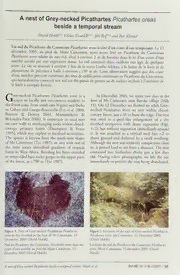
A nest of Grey-necked Picathartes Picathartes oreas beside a temporal stream PDF
Preview A nest of Grey-necked Picathartes Picathartes oreas beside a temporal stream
A nest of Grey-necked Picathartes Picathartes areas beside a temporal stream DavidHofdk“’\ Vaclav Gvozdik^'’^' JifiReif“'‘’ andPetr KlvaM , Un nid du Picatharte du Cameroun Picathartes areas a cote d’un cours d’eau temporaire. Le 12 decembre 2005, au pied du Mont Cameroun, nous avons leve un Picatharte du Cameroun Picathartes areas adulte de son nid, situe a environ 2 m de hauteur dans le lit d’un cours d’eau asseche envahi par une vegetation dense. Le nid contenait deux oisillons nus ages de quelques jours. Le site se trouvait a environ 1 km de la route Limbe—Idenao, a la lisiere de la foret et de m plantations de palmiers a huile a environ r. 190 alt. Cette observation suggere que des cours d eau asseches peuvent constituer des sites de nidification convenant au Picatharte du Cameroun, qui normalement construit son nid sur des parois de grottes ou de rochers inclines a I’interieur de la foret a canopee fermee. G rey-necked Picathartes Picathartes areas is a In December 2005, we spent two days at the scarce to locally not uncommon resident in foot of Mt Cameroon near Batoke village (Mile the forest zone, from south-east Nigeria and Bioko 11). On 12 December we flushed an adult Grey- to Gabon and Congo-Brazzaville (Fry et al. 2000, necked Picathartes from its nest within closed- Borrow & Demey 2001, Mamonekene & canopy forest, just r.10 m from the edge. The nest Bokandza-Paco 2006). It constructs its mud nest was sited in a pool-like enlargement of a dry on cave walls or overhanging rocks within closed- riverbed overgrown with dense vegetation (Figs. canopy primary forest (Thompson & Fotso 1-2), but without vegetation immediately around 1995), which may explain its localised occurrence. it. It was attached to a vertical rock face c.2 m The species is known from the south-west slopes above ground and sheltered by a small overhang. ofMt Cameroon (Tye 1987), an area with one of Although the nest was relatively conspicuous close the most intact altitudinal gradients of tropical to, it proved hard to see from a distance. The nest forest in West Africa. Breeding has been recorded contained two featherless chicks just a few days in steep-sided bare rocky gorges in the upper parts old. Having taken photographs, we left the site m ofthe forest, at c.700 (Tye 1987). immediately to prevent the nest being abandoned. Figure 1. Nest ofGrey-necked Picathartes Picathartes Figure 2. Environs ofthe nest ofGrey-necked Picathartes areas in dry riverbed at the foot ofMt Cameroon, 12 Picathartes areas, Mt Cameroon, 12 December 2005 December 2005 (David Hofak) (David Hofak) Nid du Picatharte du Cameroun Picathartes areas dans un Environs du nid du Picatharte du Cameroun Picathartes cours d’eau asseche au pied du Mont Cameroun, 12 areas, Mont Cameroun, 12 decembre 2005 (David decembre 2005 (David Hofak) Hofak) A nestafGrey-neckedPicathartes besidea temparalstream: Hafdk etal. BullABC Vol 14 No2 (2007)- 183 Concealed by nearby vegetation, we observed the References adult return within a few minutes. The site is at Allport, G. 1991. The status and conservation ofthreat- C.190 m, c.\ km from the main Limbe-Idenao ened birds in the Upper Guinea forest. Bird road and c.50 m from an oil-palm plantation, Conserv. Intern. 1: 53-74. & where local people were constructing a dam on the Borrow, N. Demey, R. 2001. Birds ofWestern Africa. stream (04°04’N 09°04’E). It was c.5 km from the London, UK: Ghristopher Helm. & dry stony riverbed with steep rocky cliffs where a Fry, C. H., Keith, S. Urban, E. K. (eds.) 2000. The Grey-necked Picathartes was observed in January Birds ofAfrica. Vol. 6. London, UK: Academic 2004 (Sedlacek etal. 2005). Press. & Mamonekene, V. Bokandza-Paco, F. L. 2006. Although Grey-necked Picathartes is reported Premiere observation du Picatharthe du Cameroun also to nest on cliffs below dry ‘waterfalls’ (Fry et ABC Picathartes oreas au Congo-Brazzaville. Bull. al. 2000), nesting on the bank of a temporal 13: 84-85. stream has apparently not been documented pre- & A Sedlacek, O., Hofak, D., Reif, J. Riegert, J. 2005. viously. It has, however, been reported for its con- new record of Grey-necked Picathartes Picathartes gener, White-necked Picathartes P. gymnocephalus, oreas in Cameroon. Malimbus TJ\ 44-T6. which has been found to nest alone on banks of Thompson, H. S. & Fotso, R. 1995. Rockfowl: the watercourses when large, dry, rocky overhangs are genus Picathartes. Bull ABC2: 25-28. absent (Allport 1991). Our record, and the sight- Tye, H. 1987. Breeding biology of Picathartes oreas. ing in January 2004, suggest that the banks of Gerfautll-. 313-332. temporal streams may constitute suitable breeding “Department of Ecology, Faculty of Science, Charles sites in the dry season. Although picathartes are University, Vinicnd 7, CZ-128 44 Praha 2, Czech reported usually to breed in small colonies (Borrow & Demey 2001), we did not find any Republic. E-mail: [email protected] other nests in the vicinity. Colonial breeding may ^Department of Zoology, Faculty of Science, Charles University, Vinicnd 7, CZ-128 44 Praha 2, Czech be the result of suitable breeding sites such as Republic. steep-sided rocks in closed-canopy forest being & ‘^Department of Vertebrate Evolutionary Biology spatially restricted, whereas this is not the case for & Genetics, Institute of Animal Physiology Genetics, dry riverbeds. Our finding also supports the Academy ofSciences ofthe Czech Republic, Rumburskd assumption that P. areas tolerates a certain amount 89, CZ-27721, Libechov, Czech Republic. ofhuman disturbance. ^Department of Zoology, National Museum, Vdclavske Acknowledgement ndmesti68, CZ-115 79, Praha 1, Czech Republic. We thank Ron Demey, who provided helpful com- ‘Bird Ringing Centre Prague, National Museum, Hornomecholupskd 34, CZ-102 00 Praha 10, Czech ments and language corrections that greatly Republic. improved the manuscript. Received 3 May 2006; revision accepted 19 January 2007. 184-BullABC Vol 14 No2 (2007) A nest ofGrey-neckedPicathartes besidea temporalstream: Hofdk etal.
